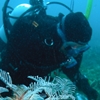General Description
Colony of individual polyps (hydranths) joined by root-like network of tubular stolons at the base. Colony shape is feather-like (pinnate). Colour: white. Up to 5 cm high.
Biology
These graceful colonies are common on jetties.
Habitat
On algae, seagrass and other invertebrates, prefers semi-sheltered areas, on jetty piles.
Reefs
Seagrass meadows
Distribution guide
New Zealand and southern Australia.
Species Group
Depth
Water Column
Max Size
5 cm
Diet
Plankton or Particles
Harmful
Generally not harmful but still able to sting bare skin.
Commercial Species
No
Global Dispersal
Recorded in Australia
Species Code
MoV 3471
Identify
Conservation Status
- DSE Advisory List : Not listed
- EPBC Act 1999 : Not listed
- IUCN Red List : Not listed





